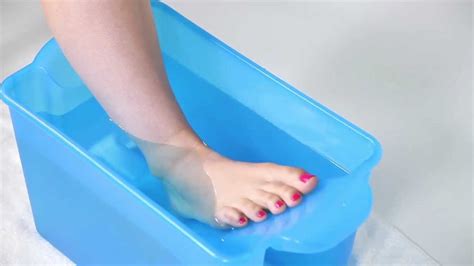Ice Foot Soaks: A Complete Beginner's Guide
Are your feet aching? Swollen? Burning? Ice foot soaks might be the answer you've been searching for. This complete beginner's guide will walk you through everything you need to know about this simple yet effective remedy for a variety of foot ailments. From understanding the benefits to mastering the perfect technique, we'll cover it all.
What are the Benefits of Ice Foot Soaks?
Ice foot soaks offer a range of benefits, making them a popular home remedy for various foot conditions. The cold temperature helps to:
- Reduce inflammation: Inflammation is a common cause of foot pain and swelling. The cold constricts blood vessels, reducing swelling and easing pain. This is particularly helpful for conditions like plantar fasciitis, sprains, and strains.
- Numb pain: The cold acts as a natural anesthetic, temporarily numbing the pain receptors in your feet. This provides immediate relief from sharp or throbbing pain.
- Decrease swelling: As mentioned, the vasoconstriction effect of the cold helps to reduce swelling in the feet and ankles. This is beneficial for those with edema or other conditions causing fluid retention.
- Soothe tired and aching feet: After a long day on your feet, an ice foot soak can revitalize and soothe tired muscles.
What are the Best Ingredients for an Ice Foot Soak?
While simply using ice water is effective, you can enhance your ice foot soak with a few additions:
- Epsom salts: These salts contain magnesium sulfate, which has anti-inflammatory properties and can help soothe sore muscles.
- Essential oils: Adding a few drops of essential oils like peppermint (for cooling and invigorating effects) or lavender (for relaxation and calming effects) can enhance the experience. Always dilute essential oils in a carrier oil before adding them to the water.
- Baking soda: Baking soda can help to neutralize odors and slightly soften the water.
How to Do an Ice Foot Soak: A Step-by-Step Guide
Follow these simple steps for the perfect ice foot soak:
- Gather your supplies: You'll need a large basin or tub, ice cubes, cold water, and any optional ingredients (Epsom salts, essential oils, baking soda).
- Prepare the water: Fill your basin with enough cold water to comfortably submerge your feet. Add your chosen ingredients, stirring gently to dissolve.
- Test the temperature: Before immersing your feet, test the water temperature. It should be comfortably cool, not painfully cold. Adjust the temperature with more ice or cold water as needed.
- Submerge your feet: Gently lower your feet into the basin and allow them to soak for 10-20 minutes. Avoid soaking for longer than 20 minutes to prevent chilling.
- Dry your feet: Once you're finished, carefully remove your feet from the basin and pat them dry with a towel.
How Often Should You Do Ice Foot Soaks?
The frequency of ice foot soaks depends on your needs and the condition you're treating. For acute injuries or severe swelling, you might benefit from doing them several times a day. For general foot fatigue or minor aches, once or twice a week might suffice. Always listen to your body and adjust accordingly. If pain persists or worsens, consult a healthcare professional.
Are There Any Risks or Side Effects?
While generally safe, ice foot soaks can pose some risks if not done properly. These include:
- Frostbite: Prolonged exposure to extremely cold temperatures can cause frostbite. Always ensure the water is comfortably cool and monitor for signs of numbness or discoloration.
- Allergic reactions: Some individuals may be allergic to certain essential oils or other ingredients. If you experience any allergic reaction, discontinue use immediately.
- Worsening of underlying conditions: Ice foot soaks are not a treatment for all foot conditions. If you have a serious underlying medical condition, consult your doctor before using ice foot soaks.
What if my feet are numb after an ice foot soak?
Numbness after an ice foot soak is a common side effect of the cold temperature constricting blood flow. It usually subsides quickly once your feet warm up. If the numbness persists for an extended period or is accompanied by other symptoms, seek medical attention.
Can I use ice foot soaks for plantar fasciitis?
Yes, ice foot soaks can be a helpful part of a comprehensive treatment plan for plantar fasciitis. The cold helps to reduce inflammation and pain associated with this condition. However, it's crucial to combine ice soaks with other recommended treatments such as stretching and orthotic support.
Can I use ice foot soaks every day?
While there's no strict rule against daily ice foot soaks, it's generally recommended to avoid overdoing it. Daily use may lead to skin irritation or damage from prolonged exposure to cold. It's best to listen to your body and use ice soaks as needed, typically no more than a few times per week.
This guide provides a comprehensive overview of ice foot soaks. Remember, this information is for general knowledge and shouldn't replace professional medical advice. Always consult with your doctor or a healthcare professional if you have concerns about using ice foot soaks or are experiencing persistent foot pain.

